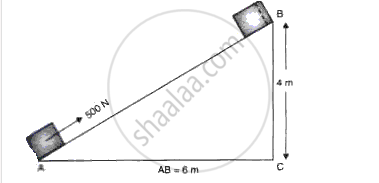Advertisements
Advertisements
प्रश्न
An object is dropped from a height H. when is its
(i) P.E. maximum,
(ii) K.E. maximum,
(iii) P.E. = K.E.?
उत्तर
(i) At the height H because the height is maximum.
(ii) At the ground level because the velocity is maximum.
(iii) At half distance of the total path i.e. at height H/2, the P.E. is equal to the K.E.
APPEARS IN
संबंधित प्रश्न
A force of 7 N acts on an object. The displacement is, say 8 m, in the direction of the force (see the given figure). Let us take it that the force acts on the object through the displacement. What is the work done in this case?

When do we say that work is done?
The moon is revolving around the earth in a circular path. How much work is done by the moon?
A boy of weight 40 kgf climbs up the 15 steps, each 15 cm high in 10 s and a girl of weight 20 kgf does the same in 5 s. Compare:
- the work done, and
- the power developed by them. Take g = 10 N kg-1.
What do you mean by degradation of energy?
The work done on an object does not depend on ______.
Its moment of a force scalar or a vector quantity?
A man carrying a suitcase in his hand is walking horizontally. What is the work done against gravity?
Define 'joule'.
What is the ratio of SI units to CGS units of 'work'?
A block of mass 20 kg is pulled up a slope (fig.12) with a constant speed by applying a force of 500 N parallel to the slope. A and B are initial and final positions of the block.
(a) Calculate the work done by the force in moving the block from A and B.
(b) Calculate the potential energy gained by the block.

Define force. Is force a scalar or a vector quantity?
A coolie is pushing a box weighing 1500 N up an inclined plane 7.5 m long on to a platform, 2.5 m above the ground.
(i) Calculate the mechanical advantage of the inclined plane. (ii) Calculate the effort applied by the coolie.
(iii) In actual practice, the coolie needs to apply more effort than what is calculated. Give one reason why you think the coolie needs to apply more effort.
